
Way back in the early 2000s, new Warhammer video games were relatively rare. Relic and THQ had pretty much sole custody of the IP, and brought us such beloved classics as Dawn of War and Space Marine. This all changed sometime after the collapse of THQ in 2013.
Games Workshop became much less protective of the license, leading to a new era where tons of Warhammer games began to flood the market. Unfortunately, a lot of them tended to range from uninspired to garbage, especially all of the quick mobile cash grabs.
While the general quality of Warhammer games has stabilized a bit since then, their frequency hasn’t really slowed down. If it feels like a new Warhammer game comes out every few weeks, its because they kind of do. Warhammer Age of Sigmar: Storm Ground and Necromunda: Hired Gun were released by the same publisher less than a week apart, and now we have Warhammer 40,000: Battlesector.
While Focus Home Interactive and Creative Assembly are probably the most famous of the developers frequently releasing new Warhammer games and DLC; Slitherine have published a fair number of them as well.
Seeing as how they specialize in publishing fairly complex wargames, the Warhammer IP is the perfect fit for their catalog. Their range of 40k games includes Armageddon, Sanctus Reach, and Gladius – Relics of War.
These titles might not be as famous as the likes of Dawn of War or Total War: Warhammer, but they have all been moderately successful and well-received by the community. Battlesector is developed by Black Labs Games, the team behind the fairly popular and successful Battlestar Galactica Deadlock game also published by Slitherine.
Of Slitherine’s previous 40k games, Battlesector is probably the most like Sanctus Reach, and provides fans of Warhammer and turn-based tactics games another pretty solid title that only really falters when it comes to the amount of content you get for the price.
Warhammer 40,000: Battlesector
Developer: Black Lab Games
Publisher: Slitherine
Platforms: Windows PC (Reviewed), PlayStation 4, Xbox One
Release Date: July 22nd
Players: 1-2
Price: $39.99
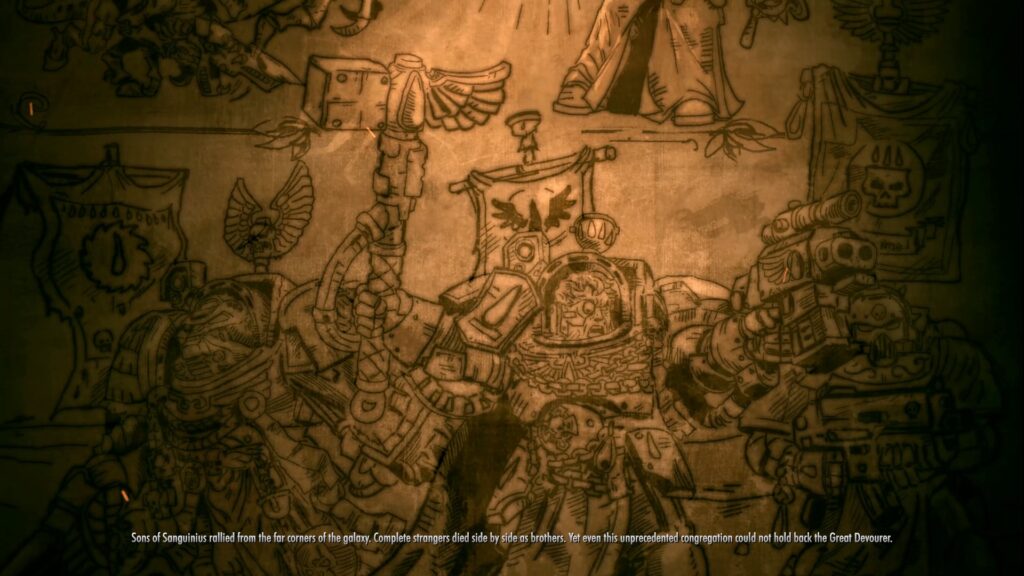
Warhammer 40,000: Battlesector is set after the Devastation of Baal, one of the most catastrophic battles of the Third Tyrannic War. The Blood Angels’ homeworld was assaulted by an unimaginably large force from Hive Fleet Leviathan. By the time the battle was over, nearly a dozen Successor Chapters were completely wiped out, with the Blood Angels themselves suffering severe casualties.
The Devastation of Baal happened at a particularly dark time for the Imperium. Cadia had recently fallen in the 13th Black Crusade, and the Imperium was ripped in half by Warp Storms in an event known as the Cicatrix Maledictum.
Baal, and the Imperium as a whole, were only saved due to the efforts of the newly-revived Primarch Roboute Guilliman and his Indomitus Crusade; spearheaded by a new breed of enhanced Space Marines created by Belisarius Cawl in the depths of Mars.
Battlesector‘s campaign follows Sergeant Carleon, a veteran Assault Marine that has been charged with testing the Blood Angels’ Primaris reinforcements by mopping up the remnants of Hive Fleet Leviathan that still persist on Baal Secundus. This seemingly simple task leads to the realization that Leviathan might not be defeated quite yet.
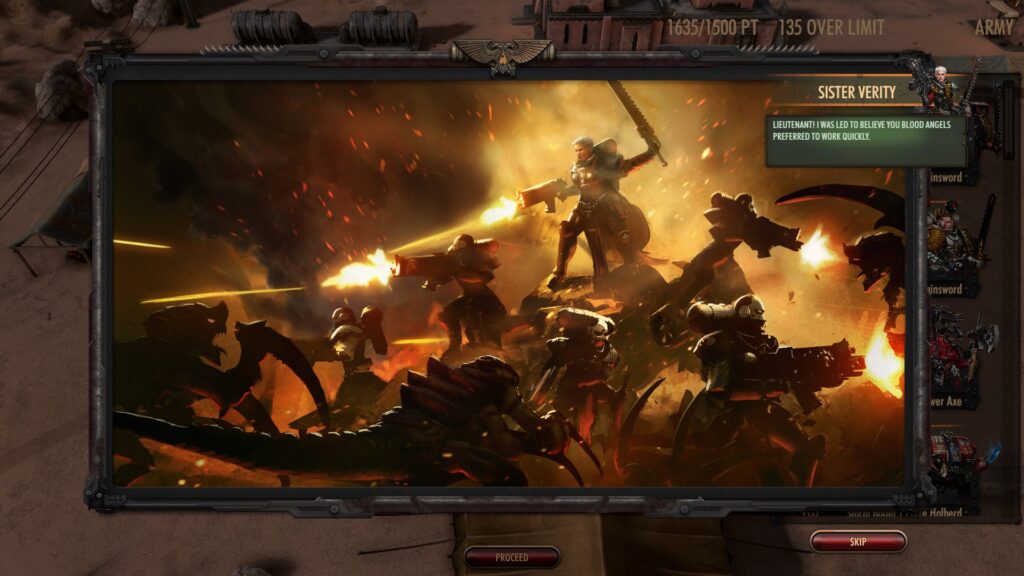
The general campaign flow involves fighting through a linear selection of missions across Baal Secundus, with basic cutscenes before and after each mission that push the story forward. You’ll start with a small selection of basic units like Assault Marines, Primaris Intercessors, and Aggressors; and gradually unlock new troop choices as you progress.
You can keep a roster of 20 units at a time, and can freely recruit or retire units as you see fit. A rather disappointing omission in the game’s campaign progression is that it doesn’t really matter if your units survive to see another skirmish. Units don’t level up or improve over time; the only indication a specific unit has been around with you for the long haul is a basic status bar that lists the missions they have survived.
This is probably because the developers didn’t want to punish you for things that aren’t really in your control. Tyranid units like the Exocrine can easily obliterate a unit of Intercessors from beyond your line of sight, so I’d imagine that losing a heavily customized veteran unit you’ve had for 10 missions to such cheese would be endlessly frustrating.
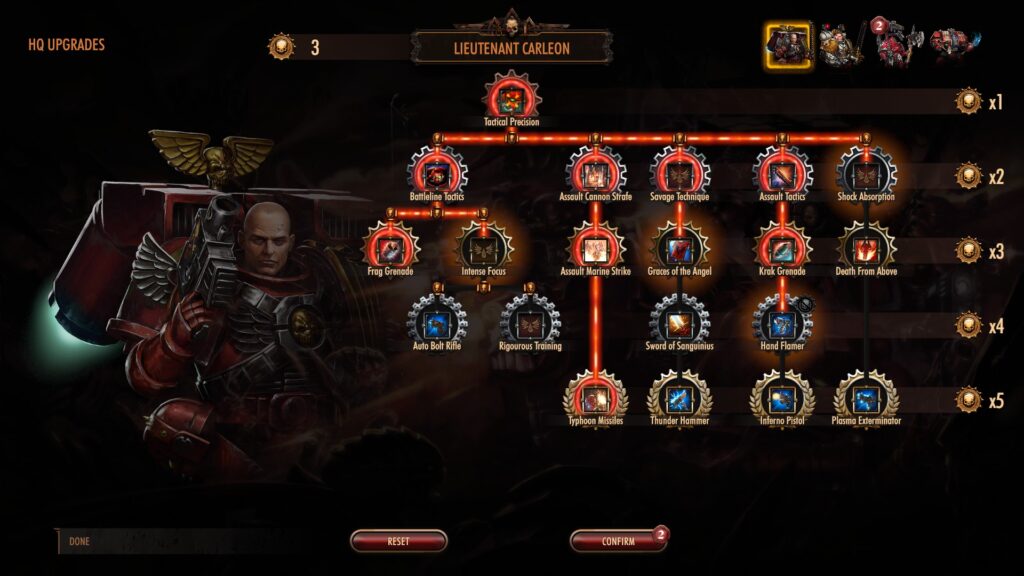
That isn’t to say there isn’t any progression at all in the campaign, however. Carleon is accompanied by a variety of hero characters, each of which has a tech tree associated with them. You gain tokens that can be spent to unlock upgrades from these trees. A few of them only affect the hero themselves, but many of them are army-wide buffs.
Some of these include pretty standard stat increases, like +20 health for your vehicle units. Meanwhile, others unlock new activatable abilities or weapon options. You might unlock the ability for Hellblasters to perform overcharged shots with their plasma incinerators, or give Intercessors access to frag grenades.
In terms of weapon unlocks, these include things like being able to have Assault Marines replace their Bolt Pistols with Hand Flamers or Inferno Pistols; or Intercessors swapping their more accurate and powerful Bolt Rifles for Auto Bolt Rifles that can put more shots downrange.
While you can keep 20 units in your reserves, you are limited by point costs in each mission. This means you’ll probably have to do some tweaking in the pre-battle screen by benching some units, or tinkering with weapon loadouts for the units who have them.
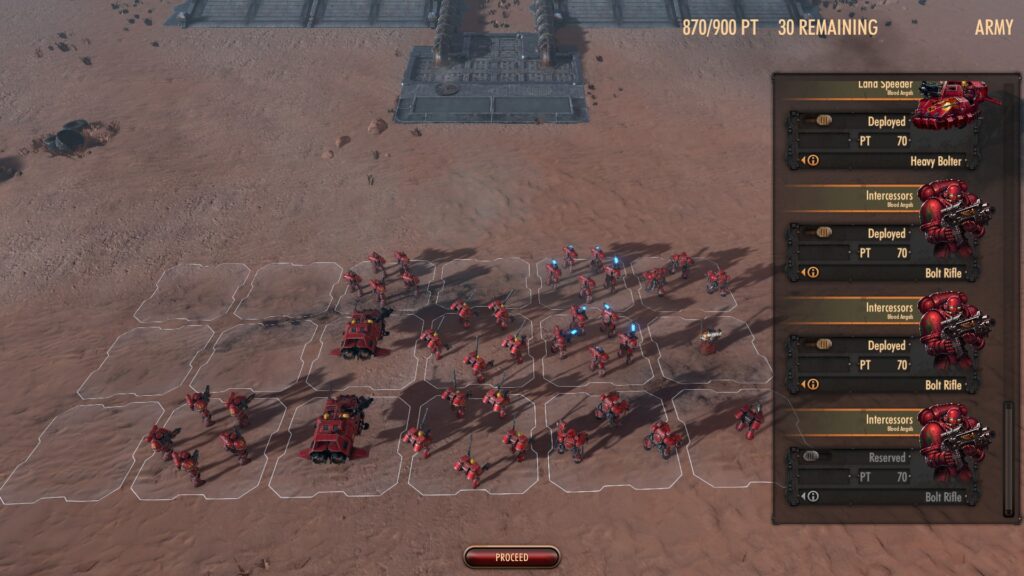
Speaking of the pre-battle screen, it’s pretty fiddly. You have a predetermined set of spaces that makes up your deployment zone, and placing your units where you want them can be tedious.
The drag and drop interface requires you to hold the mouse button down; and worse yet, you can’t swap units around by placing them on top of another unit. Instead, to swap the positions of two units you’ll need to drag them to an empty space and then go back to pick up the unit you want and place it into position.
There are a few other finicky things about the interface and menus here and there; like the lack of double-clicking to open some menus, or the necessity to click or press specific buttons to advance to a menu instead of pressing a shortcut key.
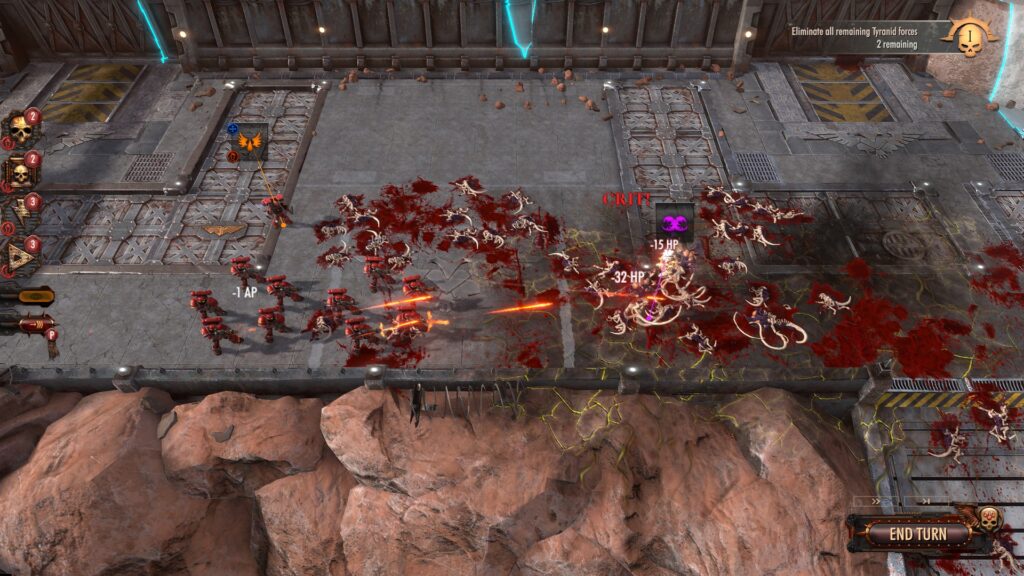
As I mentioned earlier, the core turn-based battle mechanics of Battlesector are somewhat similar to Slitherine’s earlier 40k game, Sanctus Reach. The battlefield is divided into a grid-based map, and you and the enemy will take turns moving and attacking with your armies.
Units all have a set movement value that allows them to advance that many spaces, as well as a single action point that can be used to attack or use a special ability. Though some abilities are “free” actions with a cooldown that lasts a few turns. Meanwhile, hero units typically get two action points.
As you’d expect from such a system, units can choose to expend their AP to get a bit of extra movement. One of the things you’ll immediately notice about actions and movement in Battlesector is how incredibly slick and streamlined it is. You don’t have to wait for a unit to finish moving or performing actions before you move on to the next, and you can freely return to a unit if you suddenly find yourself wanting to resolve a different unit first.
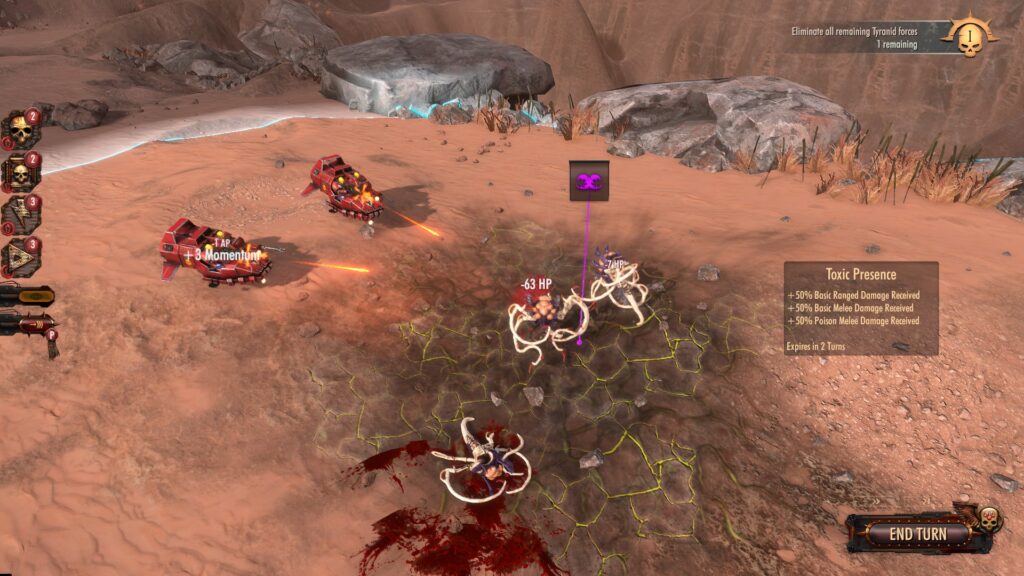
This allows you to easily chain together activations; like moving two units up, firing on an enemy, and moving on to a different unit’s actions. It also means that if you haven’t used up all of a unit’s movement points and suddenly realize they are in the way, you can go back to them to move them into a better position.
Units themselves are grouped about how you’d expect if you are familiar with the tabletop game. Your vehicles tend to be a single model, while infantry are squads where each individual member has their own health and attack pools.
Because of this, your infantry squads will degrade in effectiveness as they suffer casualties. If you have a healer like an Apothecary you can patch up wounded squad mates, but can’t revive dead ones.
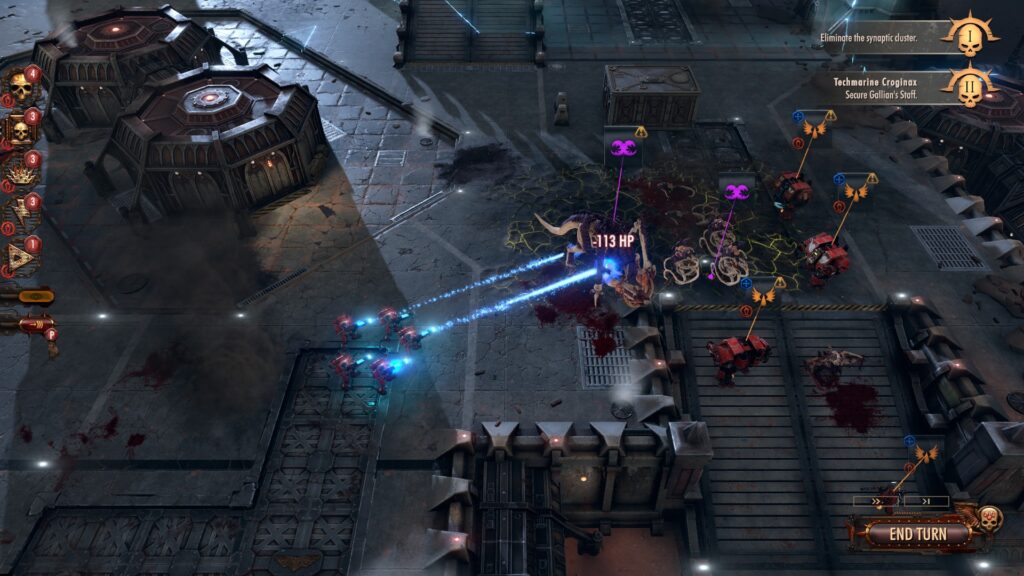
Battlesector does a pretty good job of translating the general ideas of tabletop 40k into a turn-based PC game. Ranged units can spend an AP to set up overwatch, melee units can charge if their have a straight path to an enemy unit, and so on. Other mechanics include pistol reactions when a unit is being charged, and zones of control that allow a melee unit to smack some enemies that try to disengage them.
Overwatch and pistol reactions have uses beyond just damaging enemies charging at you. They can also suppress them, reducing their movement points as they come in for the charge. This can potentially make a unit fail a long charge altogether, leaving them vulnerable and out in the open. So you probably shouldn’t throw your Hormagaunts headlong into a firing line of overwatching Marines.
Conversely, the game does have some positional bonuses that encourage you to strike enemies from the side and rear. Doing so will not trigger overwatch or retaliatory melee attacks, allowing you to more safely strike your enemy.
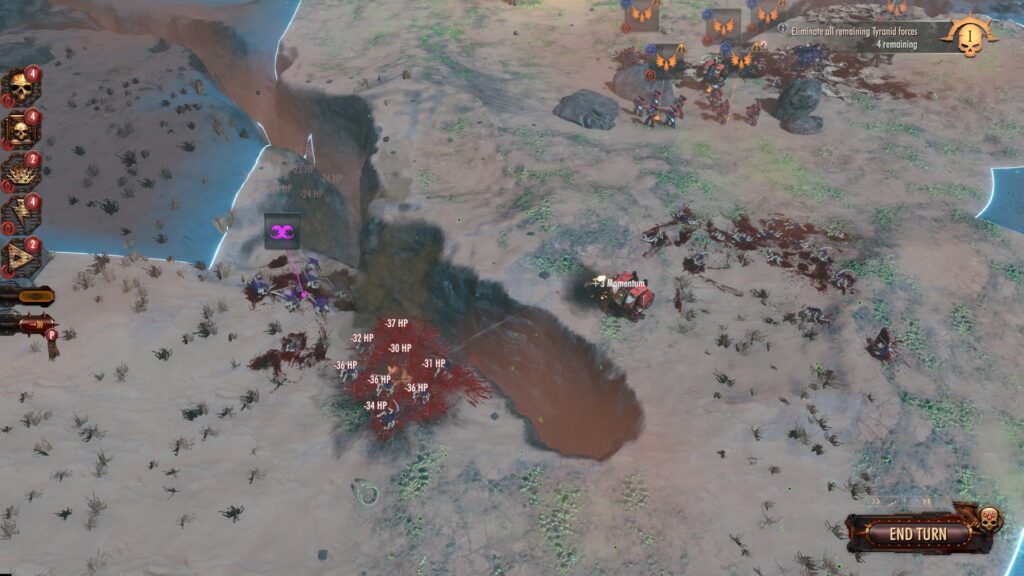
While Battlesector doesn’t really play like the tabletop game overall, it translates a lot of units and their abilities in ways that experienced 40k players will find intuitive. As mentioned before, Hellblasters can overcharge their Plasma Incinerators to increase their damage at the risk of suffering casualties, Aggressors can choose to forfeit movement to get more shots, Meltas are better the closer you are to your target, and so on.
There’s also some detailed stats under the hood that nicely replicate the tabletop game’s Strength vs Toughness concepts. Damage is calculated by comparing the target’s armor to your weapon’s AP value, and there is also accuracy falloff to take into account. Ranged weapons have more to consider than just their maximum range, as most of them have an optimal range band where they are most effective.
One of the liberties taken in Battlesector‘s mechanics is the idea of Momentum. Units fill a Momentum bar as they fight and kill enemies, though the exact nature of gaining Momentum depends on the faction.
Once this bar is full, a unit can choose to either expend their Momentum to get an extra AP, or perform an enhanced version of a special ability. Units lose some Momentum if they go into overwatch, or end a turn without spending their AP.
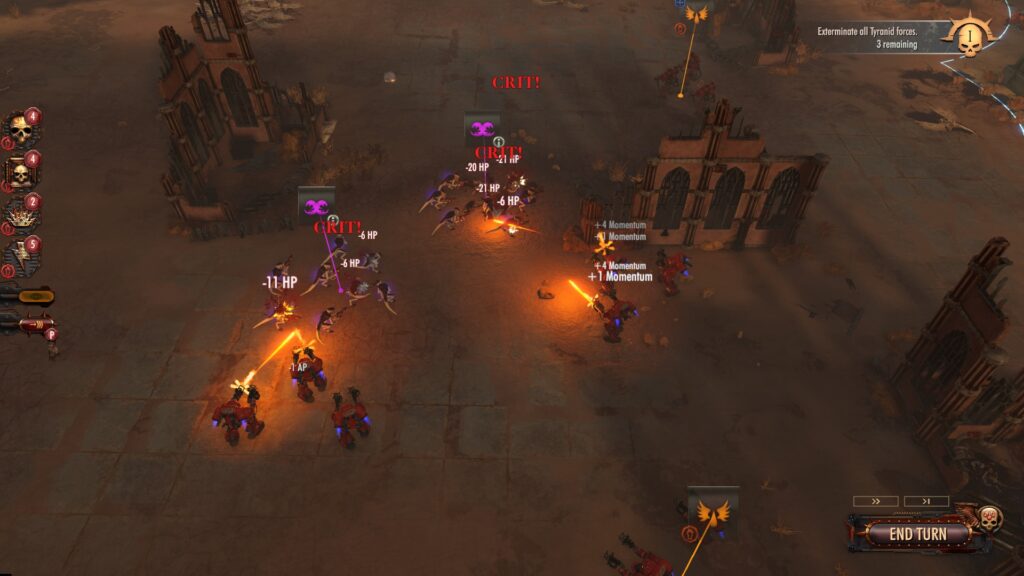
This encourages you to play aggressively instead of just slowly advancing your troops up the field going into overwatch every turn. You’ll need to carefully consider if it’s better to put a unit into overwatch, or just find something for them to shoot instead so they can keep that Momentum bar going up.
Another aspect of combat is the Command Point system. This is very loosely inspired by CP and Stratagems in the tabletop game, and allows you to call in various support options. You’ll fill a gauge as you damage and kill enemies, and once full, you’ll gain a CP. Carleon can use an AP and CP to call in fire support abilities.
For 1 CP you can call in a strafing run from a Stormraven Gunship. At 2 CP you can call in an Assault Marine squad that will drop down on an enemy unit and be added to your army for the rest of the battle. Finally, at 3 CP you can call in a Typhoon missile strike.
The system is pretty watered down compared to its tabletop equivalent, but it’s still a nice selection of cool and visually satisfying abilities. My largest complaint is that the rate at which you gain CP could probably be tweaked. It is really hard to get 3 CP to call in that Typhoon strike, and most of the campaign missions will be over before you get a chance to.
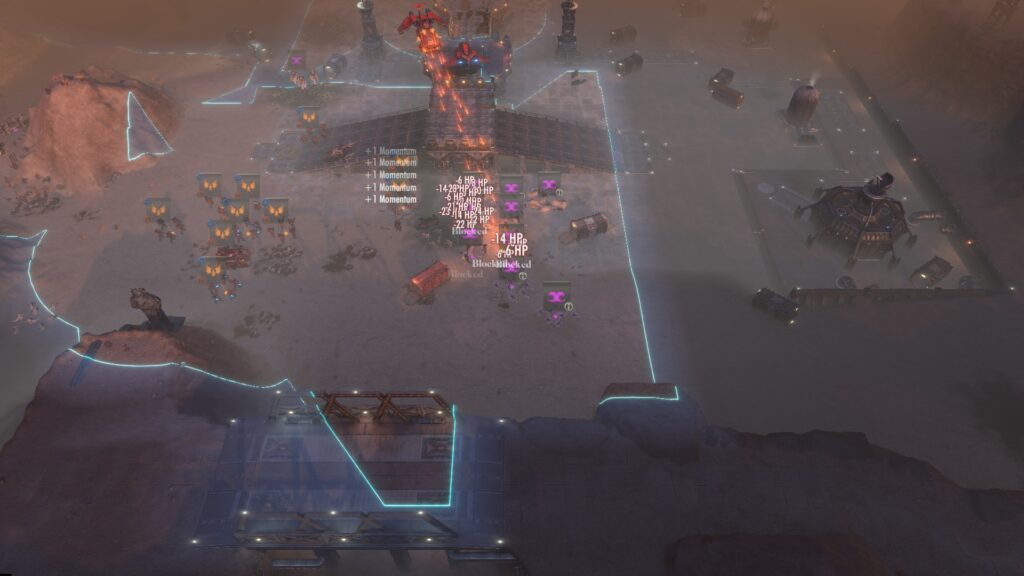
In terms of sound and visuals, Battlesector does a good job of bringing the franchise’s various units to life. While the visuals aren’t amazing, they certainly get the job done.
Grenades and bullet-spew weapons like assault cannons look pretty nice in action, and there’s lots of gore and blood splatter like you’d expect from a 40k game. Bolters sound nice and beefy, and Tyranids make great popping noises when they are turned into a fine mist by them.
That said, there are various visual glitches and sloppy animations like you’d expect from a lower budget game. It’s not uncommon to see tracers or bits of units clip through the terrain or each other, and it’s especially noticeable with flying units like Gargoyles.
Judging line of sight can also be fickle at times, especially on maps with lots of big structures. I’ve even had enemies shoot at me from the other side of said large structures. Elevation only makes the shoddy line of sight problems more noticeable.

The game’s performance is also kind of mediocre for a game like this as well. I’ll admit that I don’t exactly have the most up-to-date hardware, but I was still getting frequent frame drops below 50. Seeing as how this is a turn-based game, the performance doesn’t really affect your ability to play, but it is noticeable and annoying.
While Battlesector is a fun turn-based tactics game with solid mechanics, I do have my complaints about it. Namely, that the game could just use more content.
The game only includes the Blood Angels and the Tyranids, and of those only the Blood Angels have a campaign. Considering that 40k has a dozen factions when you only take into account the major Space Marine Chapters alone, Battlesector doesn’t even begin to scratch the surface.
The developers released a trailer a while back showing that the Sisters of Battle were in the game. While this is technically true, they are limited to just a few units in the campaign, and aren’t a proper, playable faction in the skirmish and multiplayer modes. As a Sisters of Battle player myself, this is extremely disappointing.
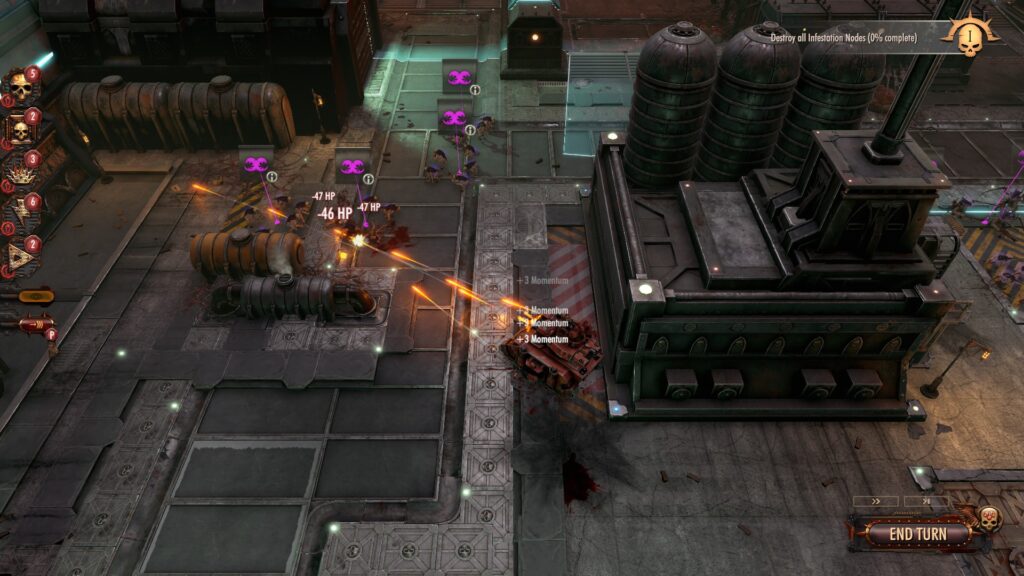
Battlesector‘s two playable factions do have a decent variety of units, but there are still tons of notable, fan favorite exclusions. Some of the absolutely iconic units that aren’t in Battlesector include Terminators, Land Raiders, Rhinos, any form of Space Marine biker units, Sanguinary Guard, Chaplains, Zoanthropes, Tyrant Guards, any type of Carnifex outside of Thornbacks, Ripper Swarms, Biovores; and many more.
I can understand some of the newer Primaris stuff not being there. The late 8th Edition and 9th Edition models like Heavy Intercessors, Infiltrators, Stormspeeders, Outriders, Bladeguard Veterans, and so on are all still very new, and Battlesector was undoubtedly well into development when those came out.
But the lack of such iconic and beloved units like Terminators, Land Raiders, or any Predator variant besides the Baal Predator is just really confusing. The game doesn’t have any sort of transports at all in fact; which have always been a huge part of 40k and the various strategies you can build around.
Battlesector also just doesn’t go far enough with its weapon loadout customization. You can swap out guns on some units, like giving a Dreadnought a heavy flamer or melta, but there are tons of weapon options that just aren’t really translated into the game.
This is especially noticeable in the melee weapons department, and the complete lack of customizable leaders within your units. More weapon customization would be a perfect way to min-max your point costs when building an army; because as it stands you’ll often find yourself a little over or under the point limits.
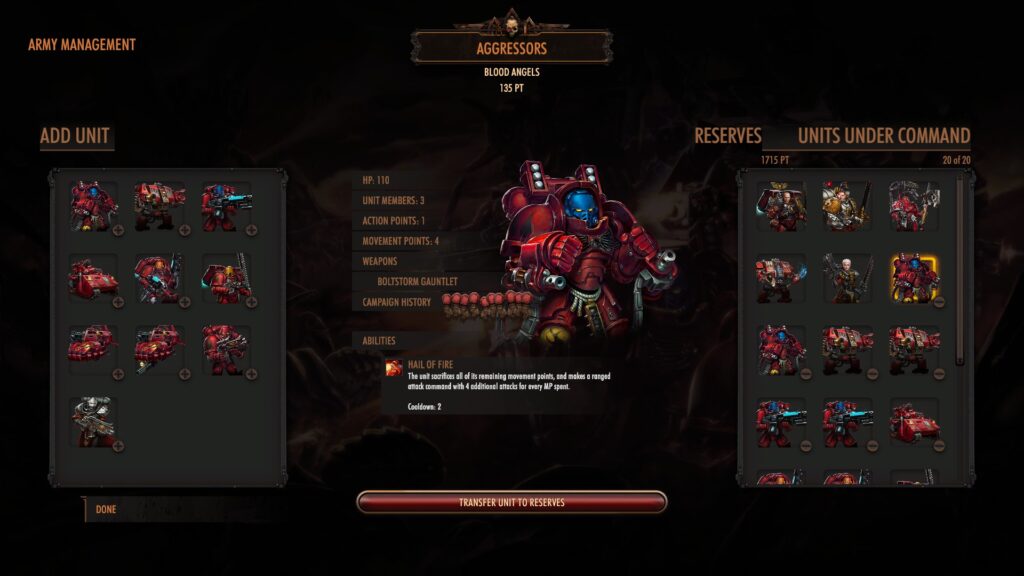
Stepping away from the nerdy grognard complaints about the lack of iconic units and loadout customization, Battlesector has a few other issues that detract from it at times. For one, campaign missions can drag on a bit too long.
You’ll typically have a primary objectives that, once completed, turns to “exterminate the rest of the Tyranids.” This drags out missions for too long as you begin searching the map for the last enemy unit or two so you can finish up.
Speaking of which, the game doesn’t have a mini-map. This can make navigating some of the larger levels where you are encouraged to split your forces annoying, as you’ll need to scroll to where they are, or hit the “next unit” button on the UI.
There is one particularly annoying example of how this can get tedious early on, where you are given reinforcements on the other side of the map in the form of a pair of Land Speeders. They have a ton of ground to cover, and the lack of a mini-map makes swapping between them and your main force rather irritating.

Finally, the AI can make some rather bizarre choices at times. Sometimes they’ll suddenly decide to move a unit through several zones of control; almost certainly resulting in the unit being eviscerated by chainswords wielded by angry Marines that aren’t just going to stand around. Other times you might see them move a unit, only to come back to it again later to shift it to a random adjacent space.
While Warhammer 40,000: Battlesector makes some missteps here and there, it’s overall a pretty solid turn-based tactics game that will undoubtedly appeal to Warhammer fans. The core mechanics are fun, and do an admirable job of translating 40k to a turn-based tactics PC game.
There is a good amount of depth to its mechanics, and it looks decent in motion if you can look past some janky animations and clipping from time to time. My biggest complaints with Battlesector are less about the core game itself, and more about my inner 40k nerd wishing there was more content.
A mere two playable factions, with only one of them having a campaign, is pretty anemic. I’m sure even casual strategy fans will be disappointed that there are only two factions to choose from, to say nothing of 40k fans wanting more of the game’s ridiculous number of races represented.
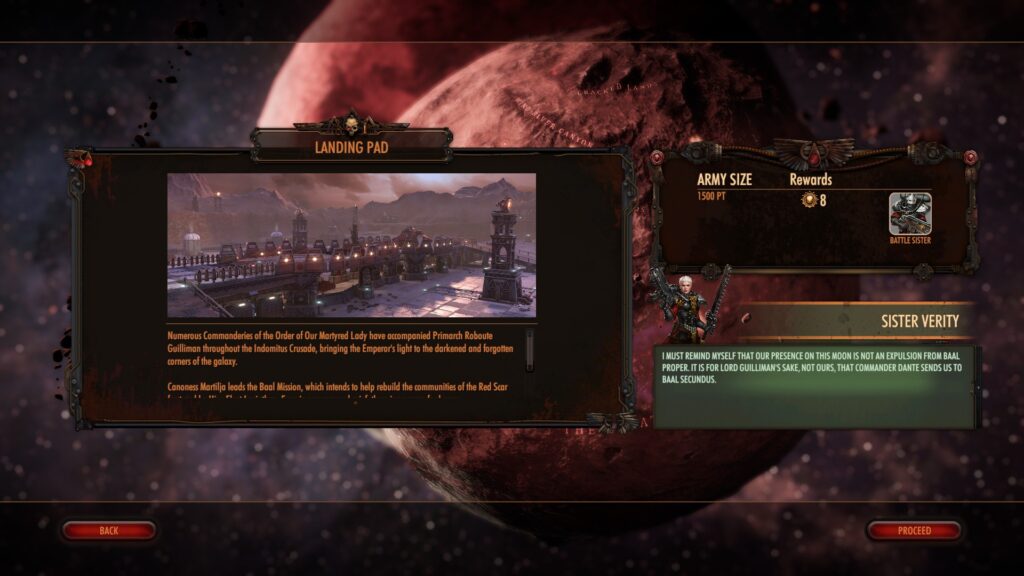
Still, despite its flaws, Battlesector is nevertheless a good new addition to the ever-expanding library of 40k video games. Whether you are a complete 40k virgin, or a long-time veteran of the tabletop game, you’ll probably find a lot to like here.
Black Lab Games supported Battlestar Galactica Deadlock for several years after release, so hopefully that’s a sign that my complaints about the limited faction and unit roster will be addressed with time. Battlesector has a pretty good foundation already, and considering the vast amount of units and factions they can pull from, hopefully we’ll see more added to the game in the coming months and years.
Warhammer 40,000: Battlesector was reviewed on Windows PC using a review code provided by Slitherine. You can find additional information about Niche Gamer’s review/ethics policy here.